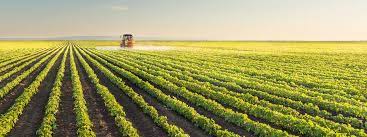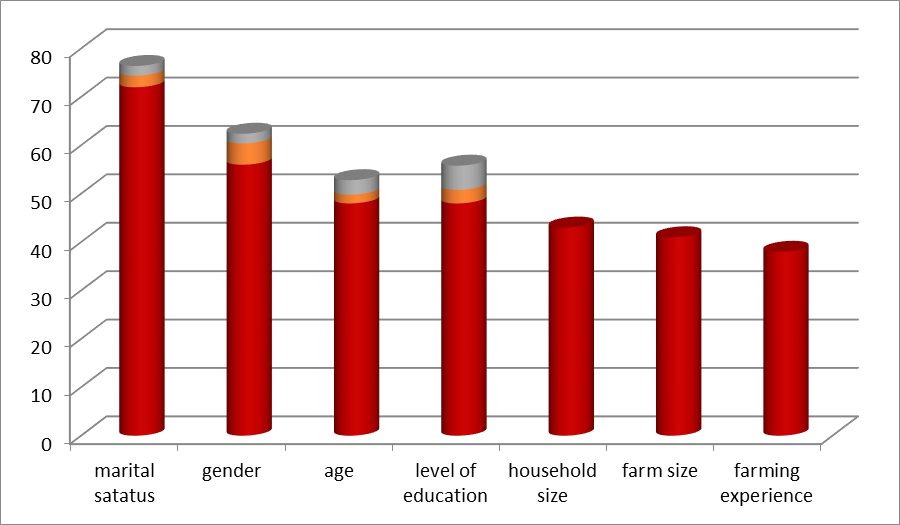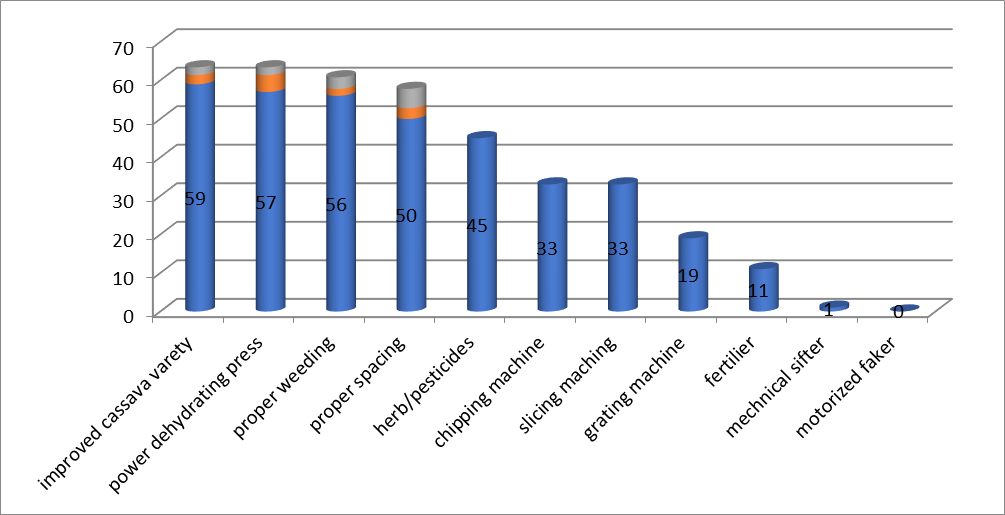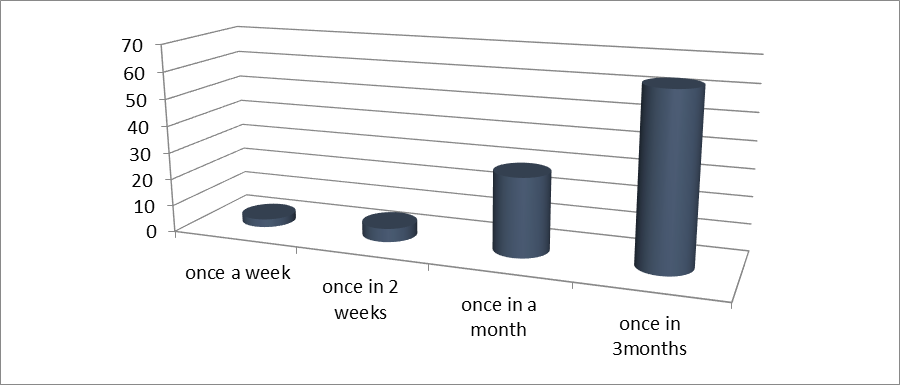
Ezike Deborah Ngozi, Sennuga Samson Olayemi * and Afolayan Oyenike Adesola
Department of agricultural Extension and Rural Sociology, Faculty of Agriculture, University of Abuja, FCT, P.M.B.117, Abuja, Nigeria.
*Corresponding authors: Sennuga Samson Olayemi, Department of agricultural Extension and Rural Sociology, Faculty of Agriculture, University of Abuja, FCT, P.M.B.117, Abuja, Nigeria.
Received: January 10, 2022
Accepted: February 04, 2022
Published: February 10, 2022
Citation: Ezike Deborah Ngozi, Sennuga Samson Olayemi and Afolayan Oyenike Adesola. (2022) “Factors Affecting Farmers Adoption of Improved Agricultural Technologies in Cassava Production and Processing in Kuje Area Council, Abuja.”, Journal of Agricultural Research Pesticides and Biofertilizers, 3(4); DOI:http;//doi.org/02.2022/1.1063
Copyright: © 2022 Sennuga Samson Olayemi. This is an open access article distributed under the Creative Commons Attribution License, which permits unrestricted use, distribution, and reproduction in any medium, provided the original work is properly cited.
The main purpose of this study is to identify the factors affecting farmers’ adoption of improved technologies in Cassava production and processing in Kuje Area Council of the Federal Capital Territory. The study was guided by four objectives. Five communities (Kabi, Rubochi, Chibiri, Kwaku and Gaube) were selected out of ten communities in the study area due to high agricultural activities in those areas. One hundred respondents were randomly selected that is, 20 respondents from each of the five communities and primary data were collected through the use of structured questionnaire. The data was analyzed using frequencies and percentages and the result showed that age of the respondents, gender, educational status, family size, farm size and extension contact influence the adoption of improved technologies. The study also revealed that high costs, unavailability, ignorance, being unable to afford the technologies are constraints of adoption. The following recommendations were made: the government, through the extension agents should increase the extension-farmer contacts to at least twice monthly and to solve the issue of cost, government can make technologies available at a subsidized rate.
Introduction:
Agricultural technology is the use of technology in agriculture with aim of improving yield, efficacy and profitability. Consequently, to curtail food and nutritional insecurity, which is a problem in our society today, smallholder farmers as a matter of fact must adopt improved agricultural technologies to increase productivity of food crops (Sennuga, et al., 2020; Jegede, et al., 2021). Technology is primarily of two components which are physical components and informational components. Technology as physical components are such items as products, tools, equipment, techniques and processes while informational components of technology include know-how in management, marketing, production, skilled labour etc. Technology is considered to be the most important factor that increases the growth of agriculture in terms of productivity (Oyewole and Sennuga, 2020). The use of technology in Agriculture has to do with the application of technological innovations into production, storage and processing of agricultural products to improve efficiency. The improved technologies of Cassava production and processing includes the use of improved varieties, fertilizers, new tillage practices, use of mechanization, the use of herbicides and pesticides, proper spacing motorized graters, motorized flakers, mechanical sifters, etc. Increase in farm productivity which invariably increases farmers income and also reduction of poverty can only be achieved by adoption of these improved technologies (Jegede et al., 2021)
The creation of awareness of these improved technologies by the extension agents and the availability of the technologies is one thing while the adoption of the technologies by the farmers is the most important thing. The process of adoption does not happen automatically rather it is a mental process that passes through five different stages which are awareness stage, the interest stage, the evaluation stage, and then the adoption stage (Cheteni et al., 2014; Sennuga and Oyewole, 2020). Wherever there is a successful adoption of improved technology, there is always an increase in productivity which invariably increases earnings and lowers poverty. According to (Sasore, 2005) if there must be increase in the efficiency of agricultural production through agricultural modernization, farmers must to a large extent adopt improved agricultural technologies into their farming operations. However, agricultural extension communication, in the context of development, is specifically targeted toward improving the livelihoods of the participants (the farmers and extension staff) through the process of exchanging agricultural information between themselves and others (Fadiji and Sennuga 2020; Jegede et al., 2021).
Even though some breakthroughs have been made worldwide in the area of improved food processing technologies, Nigerian farmers still rely so much on traditional methods of processing which in turn reduces the level of productivity. The traditional methods of Cassava processing are so laborious that alternatives in form of improved processing technologies have been put in place in order to reduce the drudgery and labour intensive traditional Cassava processing methods and also to increase output. However, the adoption of improved agricultural technologies is found to be generally slow even though it is a sure way out of poverty in developing countries (Bandiera and Rasul, 2010; Simtowe, 2011).
Cassava (Manihot Spp) is one of the crops that have to be cultivated extensively for human consumption as well as for industrial use. Cassava tubers cannot stay for more than one week after harvesting without rotting in other words; it is highly perishable and therefore needs to be processed immediately after harvest to avoid spoilage. Any nation that is not able to preserve its food output until when needed for consumption is far from achieving food security. Consequently, to ensure that all Nigerians have unrestricted access to adequate food for healthy living round the year, Government should pay attention to the area of food processing. For this reason, Cassava farmers especially the farmers in Kuje Area Council need to be assisted and encouraged, in the use of improved Cassava processing technologies (Oyewole and Sennuga, 2020).
Cassava, Manihot esculenta is a perennial woody shrub with an edible root, which grows in tropical and sub-tropical areas of the world. It has the ability to grow on marginal lands where cereals and other crops do not grow well. Cassava can also tolerate drought as well as grow in low – nutrients soils. It provides a basic daily source of dietary energy in Africa. The most commonly consumed part of cassava is the root, which is incredibly versatile. It can be eaten whole, grated or ground into flour to be used in bread and crackers making. Cassava root is also used to produce tapioca, a type of starch as well as garri, a product similar to tapioca. This paper examines the factors affecting the adoption of improved technologies in production and processing of Cassava in Kuje Area Council, Abuja. The specific objectives are to:
Material and Methods:
This study was conducted in Kuje Area Council of the Federal Capital Territory. It is about 40km South West of Abuja. Kuje is close to the new Centenary City Development. Due to the large amounts of greenery and farmland in the area, Kuje is commonly known as “food basket of Abuja”. On this note Kuje was selected for the study. Five communities (Kabi, Rubochi, Chibiri, Kwaku, Gaube) out of 10 (Ten) communities in the study area were purposely selected due to much Agricultural activities carried out by the rural dwellers in the area since they are predominantly farmers.
Data Collection:
Primary data were used for the study, the data was collected with the aid of well-structured questionnaire which were administered to the farmers with the help of an enumerator. A total of One Hundred (100) questionnaires were administered to the farmers at the rate of 20 questionnaires in each of the five selected wards.
Method of Analysis:
The data collected for the study was analyzed using descriptive statistics (frequency, percentage) with the aid of statistical package for social science version 23. Descriptive statistics was used to summarize data in an organized manner.
Sample size:
The sample size for the study was 100 smallholder farmers. It consists of 20 farmers from each of the selected five communities namely Kabi, Rubochi, Chibiri, Kwaku and Gaube which were randomly selected.
Result and Discussion:
Table 1.1: Demographic representation of the Socio-economic characteristics of the respondents (100)
|
Variable |
|
Percentage |
|
Gender |
|
|
|
Female |
|
56 |
|
Male |
|
44 |
|
|
|
|
|
Age (Year) |
|
|
|
18 – 30 |
|
33 |
|
31 – 40 |
|
48 |
|
41 and above |
|
19 |
|
|
|
|
|
Marital Status |
|
|
|
Single |
|
10 |
|
Married |
|
72 |
|
Widowed |
|
11 |
|
Divorced |
|
7 |
|
|
|
|
|
Educational Status |
|
|
|
Primary |
|
40 |
|
Secondary |
|
48 |
|
Tertiary |
|
8 |
|
None |
|
4 |
|
|
|
|
|
Household size |
|
|
|
1 – 3 |
|
21 |
|
4 – 7 |
|
43 |
|
8 and above |
|
36 |
|
|
|
|
|
Farm size |
|
|
|
< One acre |
|
26 |
|
> 3acres |
|
41 |
|
1 – 3 |
|
33 |
Source: Field Survey (2021)
Table 1.1 above shows the socio-economic characteristics of the respondents. The variables investigated were age, gender, marital status, household size, farm size and level of education, It indicates that 56% of the respondents in the study area were observed to be females while 44% were males. This suggests that majority of those who produce and process Cassava in the study area were females probably because Cassava Production is not too tasking and laborious. Therefore, female farmers tend to have more interest in Cassava production. This
The table also shows that 48% of the respondents were within the range of 30 – 40 years of age, 33% were within the range of 18 – 30 while only 19% of the respondents were above 60years. The shows that the majority of the farmers are middle age of between 30-40 and are and active and energetic. This indicates that the middle-aged farmers are very productive and have the ability to take risk and readily adopt innovation
This is in line with Nwangi and Kariuki (2015) who intensified that the farmers that are more active in age are generally known for their risk-taking ability and eagerness to adopt new technologies.
The table also indicates that 72% of the Cassava farmers are married, 10% are single, 11% are widowed while 7% of the respondents were divorced. This suggests that Cassava production and processing are carried out mostly by married people. Due to the fact that they have more hands with their larger families which also affect farming activities positively. Because the families are larger, it is possible that agricultural information are accessed easily by them.
The table also shows that 48% of the respondents had secondary education, 40% had primary education, 8% of them acquired University education while only 4% have no formal education. This shows that the respondents in the study area have acquired the basic education that will enhance their understanding and adoption of improved technologies. This implies that there is a positive relationship between education and adoption of new technologies. In terms of household size, 43% of the respondents have household range of 4-7, 36% have household range of 8 and above and 21% of the respondent have household size of between1 –3. This suggests that the majority of the Cassava farmers in the study area have larger families which are very advantageous in carrying out farming activities.
Figure 1.1: Factors Affecting Adoption of Improved Technologies in Cassava production:

Source: Field Survey 2021
Impact of Gender on Adoption of Technologies:
The figure 1.1 (1.1) above reveals that the majority (56%) of the respondents are mostly women and this had a positive effect on the adoption of technologies. This indicates that due to the soft-hearted nature of women, they easily adopt new technologies. Moreover, women are ready to try technologies that will increase food productivity in order to cater for the children. The result of the study is against the findings made by Ojeleye et al., (2017) who stated that farming generally and particularly cassava production is mainly a male dominant affair as the male are naturally meant to be bread winners of the family.
Impact of Marital Status on Adoption of Improved Technologies:
The study showed that the majority (72%) of the farmers who produce and process Cassava in the study area are married. This is due to the fact that they have larger families and larger responsibilities such as cash for education and food and therefore, adopt new technologies faster to increase productivity and income. The widowed women and single family both male and female were less productive since they have insufficient labour and less responsibilities.
According to Mendel (2015) married couples are more likely to be more productive than single persons due to labour supply in farm activities and access to productive resources in agriculture. Because, the married families are large it is possible that agricultural information are accessed easily by them.
Impact of Level of Education on Adoption:
This study also revealed that highest population 48% of the farmers who adopted the improved technologies have acquired Secondary education. This implies that exposure to formal education enhances understanding of improved technologies and hence adoption. Oluwasola (2010) stated that lack of formal education could have serious implications on their ability to access information, use new technology innovations and even access or get credit from formal financial institutions.
Impact of Household Size on Adoption:
The result of the study also revealed that majority of those who are engaged in Cassava farming in the study area are those with average family size of 4-7 43% and 8 and above 36%.
According to Asmelash (2014) the number of people in a household is one of the factors that influence the adoption of the technology, the bigger the size of the family in a household the higher the chances of adoption as labour accessibility increases, adoption is also expected to increase.
The impact of Years of Farming Experience:
From the table, 33.3% of the respondents have been in Cassava farming for more than 5years, 23.7% have spent 3-4 years in Cassava production, 17.5% have spent 1-2 years and 15% of the respondent have spent less than one year in Cassava production and processing.
(Petros, 2010) stated that the longer the farming experience, the more farming knowledge, and technical knowhow skills are accumulated, and all of these contribute to technology adoption. This implies that the respondent who have been in Cassava farming for more than five years are more likely to adopt new technologies faster.
The impact of farm size on adoption farm Size:
Findings as presented in the table show that 26% of the farmers have a farm size of less than one acre while 41% of the farmers have farm size of more than 3 acres. Farm size is an important factor in technology adoption. The farmers that have more farm size tend to adopt technologies more than those that have limited farm size. Farmers with larger farms are likely to be better informed, be able to take larger risks associated with early adoption and have more opportunities to experiment. The result is in line with (Thomas et at,2017) who established that farmers with large farm size are wealthier than those with small farm size and can afford inputs that go with adoption.
Figure 1.2: Improved Technologies Adopted by Cassava Farmer:

Source: field survey.2021
Adoption of improved technology in the study area as depicted in the above fig (1.2) above shows that 59% of the farmers adopted improved Cassava variety. Proper spacing was adopted by 50% of the farmers. Proper weeding was adopted by 56% of the farmers, Herbicides and Pesticides were adopted by 45% of the farmers and only 11% of the farmers adopted fertilizer application. However, for processing of Cassava, 33% of the farmers adopted chipping machine, 57% adopted Power screw dehydrating press, 19% adopted grating machine, slicing machine was adopted by 33% of the farmers while only 1% of the farmers adopted mechanical sifter and motorized faker was not adopted by any of the farmers.
The least adopted technologies were fertilizer, mechanical sifter, Grating machine and motorized faker. This may possibly constitute a great impediment in output of Cassava and Cassava products in the study area. This shows that majority (89%) of the farmers do not use fertilizer in production of Cassava which may cause low yield. Ayola and Makinde (2014) reported that Cassava removes substantial amount of nutrients with the harvested roots, the highest being potassium followed by nitrogen and the use of fertilizer helps to replace them. This implies that continuous planting of cassava without application of fertilizer could make the farmland infertile.
Figure 1.3: Distribution of farmers according to methods of processing:

Source: Field survey 2021
The fig1.3 shows that 31.6% of the respondents accounting for 36 farmers use traditional method to process Cassava, only 27.2% of the respondents use improved method of processing. However, 12.3% of the respondents use the combination of traditional and improved methods while 28.9% of them do not go into processing after production. This indicates that level of adoption of improved technologies of cassava processing in the study area is low which would invariably affect the level of their productivity. This suggests that the extension agents in the study area need to strengthen their services since extension plays a catalytic role in technology adoption.
Figure 1.4: Distribution of respondents According to Extension contacts in the study area.

Source: field survey 2021
Figure 1.5: Distribution of respondents according to the number of contacts with extension agents

Source: field survey 2021
The Fig 1.4 above shows that out of the one hundred respondents only six (6%) do not have contact with extension agents while 94% confirmed to have received training on improved technologies available for Cassava production and processing. However, Fig 1.5 shows the number of contacts the extension agents had with the respondents. It actually reveals that extension-farmer contact is very poor as 63% of the respondents had contacts with the extension agents once in three months, 29% had contacts once in three months only 5% had contacts once in two weeks and 3% once in a week. From the above fig (1.5) it is clear that extension service is poor and also led to poor adoption of improved technologies. This shows that extension service is very important in the adoption of improved technology as it enhances the ability to acquire and use information required for increased productivity. According to Okuthe, (2014) extension service is assumed to have positive influence on adoption of improved technologies by farmers. The more contacts the extension agents have with farmers the more chances of adopting the technologies by the farmers because people tend to adopt innovations when they hear about it more frequently. This agrees with (Thomas et al., 2017) who stated that technology adoption among farmers is usually higher when extension services are made available because through extension services the benefits of the new technologies are made known to farmers.
Figure 1.6: Distribution of respondents according to constraints of adoption of new technologies in Cassava production

Source: Field survey 2021.
The Fig. 1.6 above shows that majority (65%) of the respondent could not adopt improved technologies due to the high cost of the technologies such as fertilizers, herbicides and pesticides, 14% of the respondent could not adopt because of unavailability of some of the technologies like the improved Cassava variety and fertilizers. However, 10% of the respondent said that they did not know about the improved technologies probably because they did not have any contact with extension agents. Moreover 9% of the respondents could not afford to acquire the improved technologies while only 2% of the respondent could not adopt the improved technologies because they felt it is more difficult to use than the traditional technologies. Hence some of the farmers continue to use traditional technologies in Cassava production
Figure1.7: Distribution of respondents according to constraints of adoption of new technologies for Cassava processing:

Source: field survey 2021
The Fig 1.7 above revealed that the majority 46% of the Cassava processing respondents could not adopt the new improved processing technologies because they could not afford the machineries due to the fact that they are small holder farmers and lack capital to acquire the improved technologies. Meanwhile 36% of the respondents complained of high cost of the technologies and 12% complained that some of the technologies were not available. However, 6% of the population complained that the technologies were difficult to operate. This indicates that the major constraint for adoption of new improved technologies for cassava processing is the cost of the machineries. This means that if the cost of the technologies is subsidized or credit facilities are made available to the farmers, the adoption will therefore increase.
Conclusion:
The purpose of this study was to determine the factors affecting adoption of improved technologies in Cassava production and processing in Kuje Area Council of the Federal Capital Territory. The findings from the study shows that Age, marital status, level of education, farming size, farming experience as well as extension contact are some of the factors affecting the adoption of improved technologies among Cassava farmers. The study also revealed that most of the farmers who produce Cassava do not process Cassava. Moreover, a good percentage of those who process Cassava still make use of traditional methods of processing due to high cost of the improved processing technologies. This implies that the farmers are ready to adopt the technologies but lack the capital to acquire them. Therefore, adoption may increase if prices are subsidized and also if credit facilities are made accessible to them. The study also showed that extension service is a major factor in adoption. The extension service in the study area was too poor, as the contacts were mostly once in three months.
Recommendation:
Following the results of this study, the following recommendations were made.